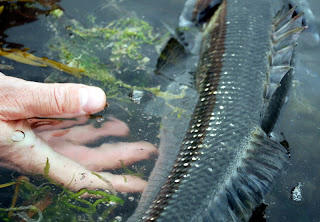They are opportunistic feeders the vast majority of the time and in a good example of the range of sources that they can consider as food a recently caught fish contained a large cuttlefish, a giant sandeel and two hard backed crabs and was also in the process of eating a 7” senko worm which he considered as another item on the menu!
The capture and storing of ‘living’ energy is a full time job especially if you have competition from other members in your group trying to do the same thing!
Swimming along in a shoal of equally hungry fish their senses highly tuned to the capture of prey, the response to feeding opportunities is based around the following (not in any particular order)
- Movement (or behaviour)
- Shape
- Size
- Colour
In this (selective) instance fish are responsive to movement and take up positions to eat but then refuse to do so – other elements in the make up of ‘prey characteristics’ become part of the decision to eat or not – that secondary trigger might be any one of the elements above – shape size or colour.
Fish see colour during daylight hours only – their eyes have evolved to perceive contrast and movement in ways in which we cant – detail is not perceived. I often hear anglers say I cant catch something on a ‘hot pink lure’ but this is only because we are limited to – ‘this is how we see it in our world’.
Fish living in the multifaceted and fractured world of an underwater environment may on occasion perceive ‘hot pink’ against an underwater background or light much easier than a grey or an olive. It gives you an angling colour contrast edge. During opportunistic feeding times you as an angler are not necessarily trying to present lures or flies that are ‘naturally realistic’ in terms of finish, there’s no harm in this but its not always necessary.
During opportunistic times if fish can see something better or more obviously against an underwater background and current light conditions by virtue of contrast and you then combine this with good movement and animation you are on a winner. Remember prey is always trying to hide, be invisible, you as an angler are trying to present prey that is more obvious to predators - don’t make it more difficult than it already is.
- Predatory fish respond to movement
- Predatory fish perceive contrast better than detail
- During opportunistic feeding times fish competing for food rely on less of the stimuli to eat your fly or lure
- Conditions will affect the way and where fish are feeding
- Behavioural movement imitation can be significant
- Make things easy for bass to eat your fly or lure


